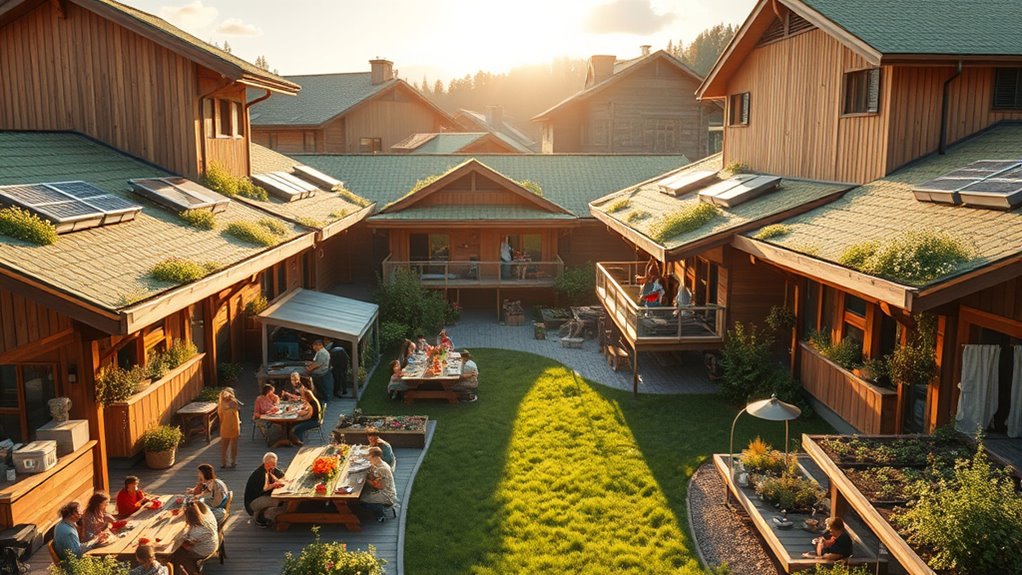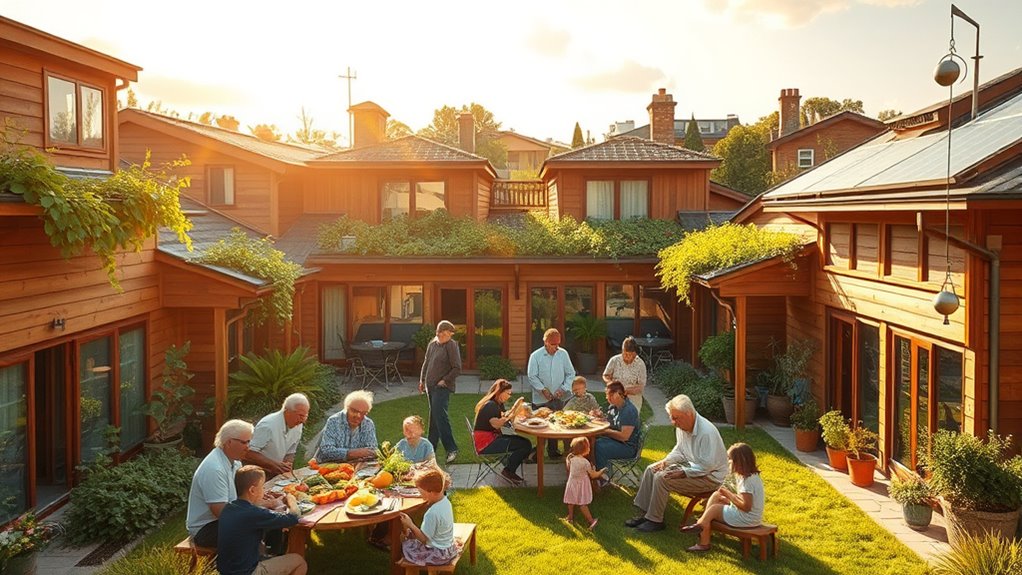Co-housing and shared living foster sustainable communities by encouraging resource efficiency and collaborative practices. You’ll use shared spaces, appliances, and collective energy sources like solar panels to cut costs and reduce environmental impact. Strong social bonds motivate eco-friendly habits such as gardening and carpooling, amplifying overall sustainability. By pooling resources and ideas, you can lower your carbon footprint and create resilient, eco-conscious neighborhoods. Stay with us to discover how these strategies can work for you.
Key Takeaways
- Shared living enhances resource efficiency through collective use of appliances, renewable energy, and eco-friendly building practices.
- Community budgeting supports sustainable infrastructure projects like solar panels and green maintenance techniques.
- Innovative technologies, such as energy management systems and real-time monitoring, optimize resource use and protect community investments.
- Social cohesion fosters eco-friendly habits like communal gardening, carpooling, and waste reduction, amplifying environmental benefits.
- Collective actions and shared spaces promote resource conservation, reduce environmental impact, and strengthen community resilience.

Have you ever considered how shared living arrangements can contribute to a more sustainable future? When you choose to live in a co-housing community or shared residence, you’re not just making a personal lifestyle choice—you’re actively participating in a movement toward environmental responsibility. One of the key benefits of shared living is its potential to enhance energy efficiency. Instead of each individual household operating independently, residents can pool resources to adopt energy-saving measures that benefit everyone. For example, sharing appliances, such as washing machines and refrigerators, reduces overall energy consumption. Common spaces like kitchens, lounges, and laundry rooms are used more efficiently, which cuts down on electricity and water use. Additionally, co-housing communities often implement collective strategies like solar panels or energy-efficient lighting systems, further reducing their carbon footprint. This cooperative approach to energy use not only lowers costs but also fosters a sense of shared responsibility among residents. Implementing airless paint sprayers for community renovation projects can also contribute to eco-friendly building maintenance by reducing waste and overspray. Moreover, understanding cost and budgeting options for community projects can help ensure sustainable growth and maintenance of shared spaces. Incorporating renewable energy sources into community planning can further amplify these benefits and promote long-term sustainability. Exploring innovative energy management techniques can optimize resource use and improve overall efficiency in shared communities.
Shared living boosts energy efficiency through resource pooling and collective strategies like solar power and shared appliances.
Furthermore, utilizing advanced fraud detection techniques such as real-time monitoring and machine learning can help protect community funds allocated for sustainability initiatives, ensuring resources are used effectively.
Beyond the tangible environmental advantages, shared living also promotes social cohesion, which is essential for sustainable communities. When you live closely with others, you naturally build stronger relationships and a sense of belonging. This social cohesion encourages cooperation and mutual support, making it easier to adopt eco-friendly habits collectively. For instance, residents can organize shared gardening projects, composting initiatives, or carpooling arrangements, all of which reinforce community bonds while reducing individual eco-impact. The sense of accountability that comes with living in a community motivates members to stick to sustainable practices. Furthermore, social cohesion creates an environment where ideas and resources are exchanged freely, leading to innovative solutions for environmental challenges.
Living in a shared setting also means you’re less likely to waste resources. When communal dining replaces individual meals, food waste decreases, and leftovers can be shared or composted. Shared transportation options, like group outings or community bikes, cut down on car emissions and fuel costs. These small, collective actions add up, making a significant difference over time. Plus, the social aspect of shared living often leads to increased awareness and education about sustainability issues. When you’re part of a community that values environmental responsibility, it becomes easier to stay committed to eco-friendly habits.
In essence, co-housing and shared living aren’t just about saving money or making new friends—they’re about creating a sustainable way of life. By boosting energy efficiency and fostering social cohesion, these arrangements provide a practical blueprint for building resilient, environmentally conscious communities. When you choose shared living, you’re not only improving your quality of life but also contributing to a healthier planet for generations to come.
Frequently Asked Questions
How Do Co-Housing Communities Handle Conflicts Among Residents?
When conflicts arise, you should prioritize open communication and active listening to resolve issues effectively. Co-housing communities foster community harmony by encouraging residents to discuss concerns respectfully and collaboratively. Conflict resolution often involves facilitated meetings or mediators to guarantee everyone’s voice is heard. By maintaining transparency and mutual respect, you help create a supportive environment where conflicts are addressed constructively, strengthening the community bonds.
What Legal Considerations Are Involved in Shared Living Arrangements?
It’s ironic that shared living sounds simple, yet legal considerations can be complex. You’ll need to navigate zoning regulations that might restrict such setups and make sure liability insurance covers everyone involved. Drafting clear agreements protects you from future disputes and complies with local laws. Ignoring these legal aspects risks fines or liabilities, turning your shared living dream into a legal nightmare. So, plan carefully and consult legal experts early.
How Is Privacy Maintained in Community-Based Living Setups?
You maintain privacy in community-based living setups by respecting everyone’s privacy boundaries and personal space. Clear communication about expectations helps prevent misunderstandings. Use physical barriers like curtains or room dividers, and establish designated private areas for each person. Setting rules for noise levels and shared responsibilities also supports a respectful environment. By actively respecting these boundaries, you guarantee that everyone feels secure and comfortable, fostering a positive community dynamic.
What Are the Costs Associated With Establishing a Co-Housing Community?
Imagine planting a garden, where seeds represent your investment. Establishing a co-housing community involves financial planning to cover infrastructure costs like utilities, roads, and shared spaces. You’ll need funds for land acquisition, construction, and ongoing maintenance. While costs vary, careful budgeting guarantees your community flourishes. Like tending a garden, nurturing this shared space requires foresight and collaboration, turning your vision into a sustainable, thriving neighborhood.
How Do Shared Living Models Adapt to Diverse Cultural Backgrounds?
You adapt shared living models by prioritizing cultural integration and addressing language barriers. You encourage open dialogue, celebrate diverse traditions, and create inclusive spaces where everyone feels valued. You might implement multilingual communication tools or cultural exchange events, fostering understanding. By actively listening and respecting differences, you help build a harmonious community where diverse backgrounds enrich the shared living experience, making it more sustainable and welcoming for everyone involved.
Conclusion
Imagine waking up in a vibrant community where gardens flourish on rooftops and neighbors share morning coffees in sunlit courtyards. Co-housing isn’t just about sharing space—it’s about building a sustainable future together, where every small act ripples outward like gentle waves. By choosing shared living, you become part of a lively tapestry of people committed to greener, more connected living. Together, you create a world where harmony and sustainability bloom side by side.









